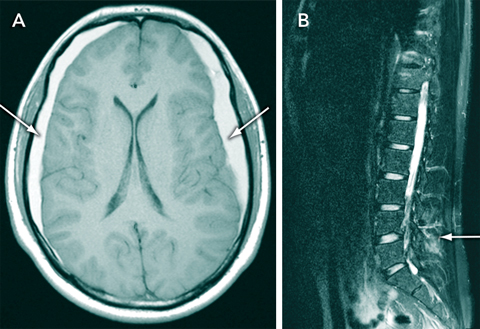A 16-year-old boy with a 3-month history of intermittent postural headaches presented with sudden worsening headache after a game of soccer. The results of a neurological examination were unremarkable. Magnetic resonance imaging showed elongation of the midbrain, bilateral frontoparietal subdural haematomas (Figure, A), and a collection of fluid within the soft tissues overlying the lumbar spine (Figure, B). The cerebrospinal fluid (CSF) opening pressure on lumbar puncture was low (60 mmHg). Spontaneous intracranial hypotension was diagnosed, and the response to conservative treatment was good.
Intracranial hypotension is a syndrome characterised by postural headaches and CSF hypovolaemia. Most cases are secondary to a tear in the dura mater following lumbar puncture, with a resultant slow CSF leak and gradual volume depletion. It can also occur secondary to severe dehydration, and, occasionally, no cause is identified, when it is termed “spontaneous”.1 In this case, there was no history of lumbar puncture, and CSF accumulation within the lumbar soft tissues was presumed to be secondary to a spontaneous dural tear in this region.
Intracranial hypotension has characteristic imaging features, which include elongation of the midbrain, linear enhancement of the pachymeninges and subdural effusions.2 Patients are predisposed to subdural haemorrhage after minor trauma as a result of “stretching” of the dural veins. Intracranial hypotension is commonly misdiagnosed as migraine, meningitis or a psychogenic disorder.1 Most cases resolve spontaneously, but intractable headaches may be successfully treated with steroids, epidural blood patches or surgery.1
- Edward Hoey1
- Guneesh Dadayal2
- Sashidhar Yeluri3
- Neetu Kumar4
- Kshitij Mankad5
- Academy of Radiology, Leeds General Infirmary, Leeds, UK.





